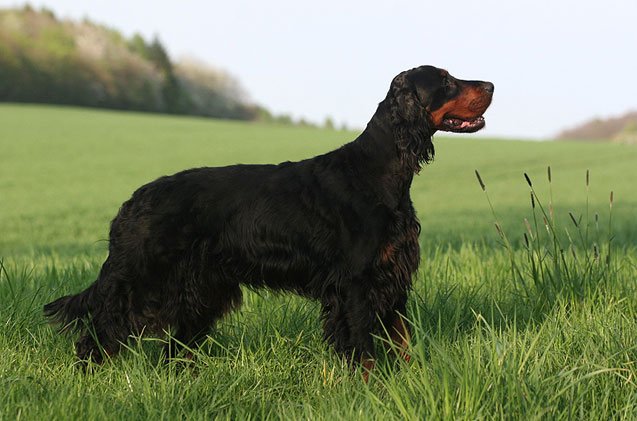The Gordon Setter was developed in Scotland in the early 17th century. This black and tan setter became popular by Duke Alexander IV of Gordon in the early 19th century. They were used as bird dogs, having an outstanding sense of smell. The dogs would point toward the fallen bird, retrieve it and bring it back to the hunter. The Gordon had great stamina and could hunt in bad weather on both land and water, but was not as fast in comparison to the pointers and as a result started to lose popularity as hunters chose other breeds. The Gordon Setter was one of the breeds that were used in the development of the Irish Setter. The Gordon makes a good one-man shooting dog. The Gordon Setter was recognized by the AKC in 1884. Some of the Gordon Setter’s talents include guarding, watchdog, hunting, tracking, pointing and retrieving.
Table of Contents
Gordon Setters as Watch Dogs?
The Gordon Setter is a striking dog that originated in 17th century Scotland. They were bred for their intelligence that allowed them to excel in bird hunting. The breed then became a sign of status for England’s wealthy. These dogs are eager to learn and have great memories. Gordon Setters can be a tad stubborn, so patient and persistent training is a must. Make sure these guys are exercised daily to prevent boredom/mischief. Gordon Setters must be brushed multiple times a week to prevent matting in their beautiful coat. These dogs make wonderful family pets as well as great guard dogs.
Are Gordon Setters Aggressive?
Gordon Setters can be dog aggressive and wary of strangers which is why socialization is deeply important.
Gordon Setters Background
BackgroundThe Gordon Setter has a Scottish background that dates back to the 17th century. The Duke of Gordon IV developed the breed in Gordon Castle. The Gordon became very popular among hunters in the early 19th century with his keen scenting abilities and intelligence. His job was to find and point to birds or other game. The Gordon is the largest and strongest of the three setter breeds. The American Kennel Club recognized the Gordon Setter in 1884.
Family and Bonding
Their current doldrums are not new, but, like a number of former working dogs that have failed to achieve mainstream appeal, the Gordon setter faces the threat of a dwindling breeding pool, with potential implications for breed wellbeing. Enlightened breeders have imported bloodstock from overseas, notably the US. Today’s Gordons may be rare, but, despite concerns about a tendency to hereditary hip dyspasia, they are currently a robust bunch.
Friendly
The Gordon Setter is the ideal roommate: protective without being mean, friendly without being clingy, dependable and patient. They are also great communicators: You never have to wonder what a Gordon is thinking, because they will howl, moan or bark when they want something.
Gordon Setter Nature
The Gordon Setter is not recommended for apartment life. It is relatively inactive indoors (if a Gordon Setter gets enough outdoor activity it will be calm when it is indoors) and does best with at least a large, safely fenced yard where it can run free. Their hunting instincts lure them to roam, so a good fence around your property is essential.
Intelligence
Gordon Setters also tend to be good candidates for dog sports like agility, obedience, tracking, flyball, field trials, and more. They’ll likely love spending time with you while being active and learning something new.
Love
Gordon Setters as a Pack Animal
This breed would make an excellent watchdog, but would not make the best guard dog. The Gordon Setter is quite gentle with children, over whom it becomes quite protective. This breed generally makes a good family dog with children who have been taught how to properly act around dogs. However, very young children are likely to be tempted to pull this dog’s long fur and ears, and it may not be ideal to house a Gordon Setter with them. The Gordon Setter can be quite challenging of an owner’s authority, and as a result is probably a much better choice for an experience dog owner than a novice.
Physical Traits
The head and face of the Gordon Setter are quite refined, which is exactly what one would expect from a British sporting dog. They sit at the end of a long and thin neck, making them appear even smaller than they would otherwise. This breed has a head which is relatively small for its body size, which ends in a quite long muzzle. This muzzle is flat at the end and should not appear pointed from the side or from above. The large size of the muzzle gives this breed extra area for scent receptors, enhancing its sense of smell. The dark brown eyes of this breed are largish in size, but not particularly prominent. They give off a keen and intelligent expression. The ears of the Gordon Setter are quite long and hang down close to the head. Although long and drooping, these ears are also triangular in shape and would not be described as hound-like. These ears are well-feathered, making them look much larger than they actually are.

